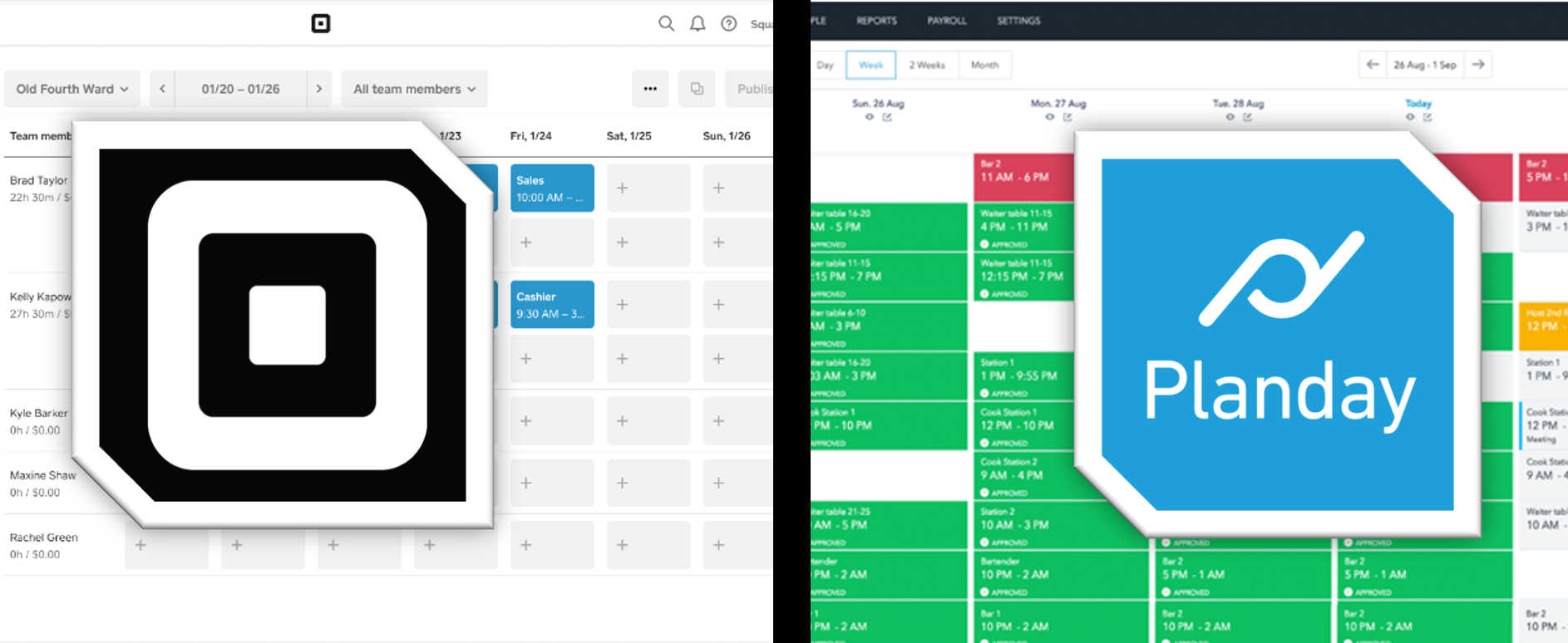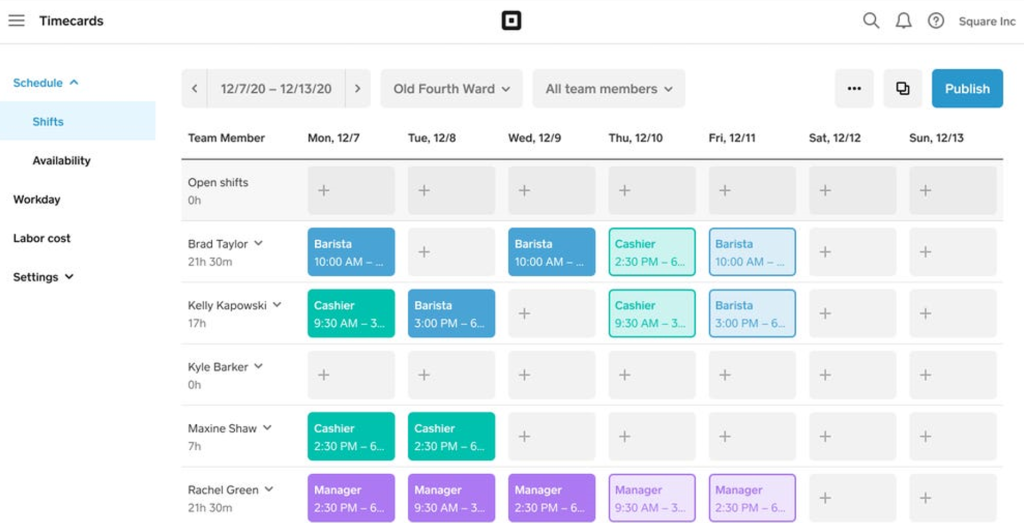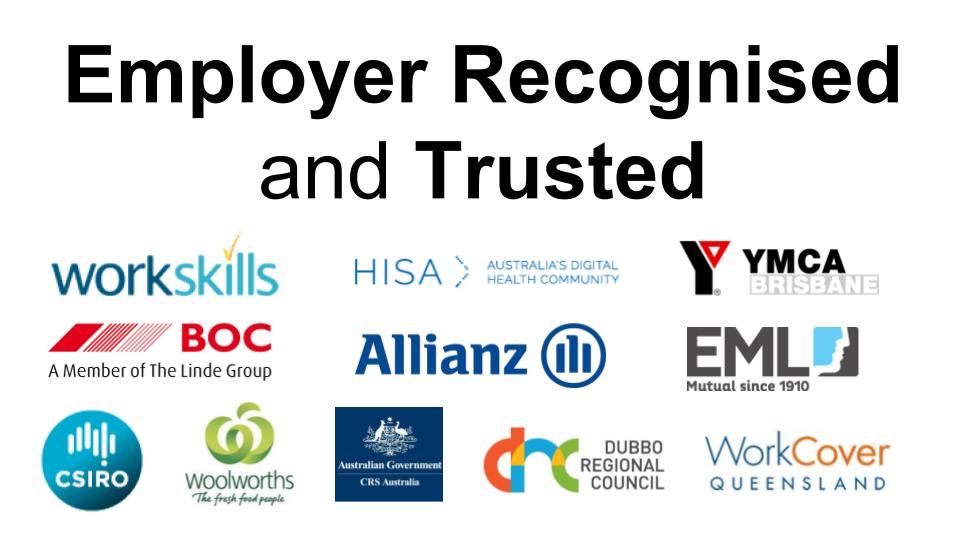
Breaking News & Updates
Xero’s financial report reveals BIG loss but share price pop. - eepurl.com/isNmKQ
Physical timesheets and all the manual data entry of employee scheduling is a hassle. Even with technology like email and text, it’s always a task to try and figure out who swapped shifts with who and coordinate a schedule that works for all your employees.
Workforce management software like Planday and Square Team Management have become popular alternatives. Planday is now owned by Xero, and Square Team Management is a service offered by digital payment company Block Inc. (formerly known as Square Inc.)
But which one should your business use? Let’s go through some of the main features you’d expect of a workforce management software, and see how Planday and Square Team Management compare:
Staff management
Adding team members to your workforce management system is pretty simple in the case of Planday and Square Team Management. You just need to enter in their name, email, wages, and job title/skill (e.g. nurse, instructor, waiter etc). In Planday, you also need to assign the employee to a specific department for your business location.
Employees can then set their availability, either via desktop or the app for their respective software. They can select all day availability/unavailability, or specific hours, and leave notes. Planday has the additional feature for employees to specify their availability for night or day shifts.
Both software also allow the employer to submit/edit availability for employees. Whilst in Planday available and unavailable team members are shown as you schedule shifts, Square Team Management shows you availability of a specific staff member once you’ve selected them for a shift.
Let’s go through some quick-fire other staff management features. Leave and time off requests, and shift swaps, are available to be made through the software’s apps, and employers can accept or deny them, however this is only available in Square’s Teams Plus subscription.
Both allow for ships to be swapped, by one team member selecting the swap/trade shift option in their app. Planday has the added feature of ‘handovers’, where the shift is given to a different employee without replacement, or ‘sell’, where colleagues can request your shift themselves. This still requires manager approval.
Shift Scheduling
Both Planday and Square Team Management allow for rosters to be created, reviewed, and edited. These rosters are created online, but can be viewed and modified on the software’s respective apps, which we’ll talk more about later.
Once you have a roster you like, both Planday and Square Team Management allow this to be saved as a template which can immediately be added to the following week, so you can schedule shifts in advance.
These software generally have very similar features in terms of scheduling. You can assign shifts to specific employees, complete with role details (like front of house, sales, warehouse etc.) or you can create an ‘open’ shift which employees themselves can then request.
You can drag and drop shifts as well, to make the process of filling out the roster a bit quicker. For instance, if an employee works the same 10am-3pm shift every day, you can drag the shift to fill out those cells. You can also copy that shift but drag it to another employee’s row, instead of creating a whole new shift.
Planday and Square Teams allow for different schedules to be made for different locations. You can also limit shifts to suitable employees – in Planday this is done by assigning a skill to certain employees, and in Square Teams it’s by job title – so only the appropriate employee can be assigned/accept certain shifts.
Now on to some differences. Whilst both software allow you to view the total hours, staff, and shifts assigned per roster, Planday has the added feature of showing you total pay (the cost of the schedule). Additionally, the Pro and Enterprise subscription tiers of Planday include auto-scheduling, where the software will fill out set shifts based on employee information and all compliance considerations.
Whilst Square will automatically calculate overtime (a feature Planday doesn’t have), Planday does have compliance warnings, which warn you when you have scheduled too many/long shifts based on business rules you enter.
And although both software can create rosters for multiple locations, Planday also allows for rosters for different sections in one location (like a department store or front and back of house).
Clock-in/clock-out
Both Planday and Square Team Management have clock-in/out options in their apps. This means an employee can simply open up their Planday or Square Team app and clock-in to their shift. Both also include clock-in limitations, meaning an employee can only clock-in to their shift
- when at their work location (apps enable location-tracking), or even
- connected to the company Wi-Fi (this is unique to Planday).
Since Square is also a POS system, you can also clock-in to your shift on the POS register. And since it’s all part of your Square Dashboard, the information syncs between all different Square services like Square Payroll, Square POS, and Square Teams etc.
Interestingly, Planday also offers a somewhat similar clock-in option to Square. Yes, they both have their apps, but Planday also offers the Planday Kiosk App for iPad, which means employees can clock-in/out on a company iPad instead of using their own device. It isn’t a POS system, of course, but it functions as a similar clock-in option as the Square POS register.
Both software include the option for a employee to record when they take a break from the app. When staff clocks-out, in Square Team Management you can also ask them to declare any tips they might have received (although this isn’t such a big deal in Australia). Planday will round the clock-in/out times to the nearest 5, 10, 15, 30, or 60 minutes.
Time tracking and timesheets
Now that your employees are using their apps to clock-in and out, you have a record of their time worked within the software. This means that you can view the hours worked by your employees, and makes reporting insights all the more detailed.
Square Team Management has the added feature of employees being able to view and print their workday summary from the shared point of sale. They can view their clock-in and clock-out hours, any breaks they took, and their total paid hours. In Team Plus, they can also leave a note regarding their shift (e.g. if they arrived late, left early etc.).
Whilst Planday doesn’t have workday summaries for employees, it does have a notes section similar to Team Plus. Team Plus also allows employees to request edits to their timecards from their Square Team app.
Whilst both Planday and Square Team Management have timesheet features, they differ a bit in their functionality. Square seems to have a more employee-focused approach to timesheets, since they’re able to be shared with and edited by employees (managers still approve all changes). Planday has all of the same features of timesheets, but it is more so for the managers and reporting purposes.
Planday timesheets are really meant for export to Xero, or other payroll providers, whereas Square is more focused on sharing this information between managers and staff. In both cases, however, a lot of the process can be done from your mobile phone via the software’s apps.
Reporting
Both Planday and Square Team Management allow you to view scheduled hours compared with actual hours worked by staff. General information like clock-in/out times, job title, breaks, notes, and leave are also easily available through both software.
All reporting options in Square are only available in Square Team Plus. But they have pretty detailed reports you can run, from individual employee sales to the labour vs sales cost of your business, as well as viewing refunds, voided transactions, or discounts provided by employees.
Planday once again is more focused on its use as integrated with other business management software. So you can run payroll forecasting and reporting, based on synced data with software like Xero, but there’s also options to forecast revenue in a similar vein as Square.
Communication
This is exclusive to Planday. It’s quite a unique feature – Planday’s app allows for messaging between employees and managers so important information isn’t lost between emails or private message chats.
Employees can message between themselves to swap shifts, or managers can message staff with important information. If the message is urgent, an employee won’t be able to continue using the Planday app until they view the message.
The app also has news and events widgets, so employees can sign up to any business or social events organised by their company. It’s a social-media style that centres on connection and communication between employees and managers.
Pricing and integration
Square Team Management is the free version of the software – Square Team Plus has additional features and comes in at $35/month.
Planday has more subscription tiers, which you can see below. There’s no free version, but there is a free trial.
Since Planday was bought by Xero last year, it integrates with the accounting software really easily. Here’s how Planday describes their integration:
Square Team Management is a little different. It doesn’t appear on the Xero App Store, or any app stores of software like MYOB and QuickBooks. Square POS, however, does integrate with software like Xero, importing transaction data from the POS to your accounting software.
Since Square Team Management is part of Square’s larger product suite, it does integrate with Square Payroll. You can import timecards from Team Plus into Square Payroll, and all the Reg Hours, Overtime, and Double time will be populated with the number of hours worked by each team member.
One issue evident is that users of Square POS and Xero, who already use that integration, aren’t able to import any information from Square Team Management into Xero. This unanswered question on Xero’s community board explains it:
This leads us to the final question: which software should your business be using?
Planday or Square Team Management?
Considering all the features they each have – many of which are very similar – the real difference between these two software is the kind of business you have. Planday claims to be for all businesses, but has a particular spotlight on retail, leisure, hospitality, healthcare, hotel, test and vaccinations.
It seems that Planday is suited for larger businesses with larger staff numbers. The communication tools on the Planday app make it great for a large staff force who need a single means of communicating, and the ability to make rosters for different locations and different departments within one location all seems to point towards larger businesses.
But it is owned by Xero – a small business accounting software – so it’s still a great option for small business, perhaps just those that employ more people. It’s also a more expensive service than Square Team Management, so that’s something to keep in mind also.
Since Square Team Management really only integrates with other Square services, it’s ideal for a loyal Square user. Square Team Management doesn’t specify which industries it targets, but most of their example images of the software show retailers or restaurants.
If you’re already using Square POS, and especially if you’re using Square Payroll, it makes sense to add Square Team Management into the mix. It’s free, and even if you do want the extra features in Team Plus, you can get access to it as part of an Appointments, Retail Plus, or Restaurants Plus subscription.
Ultimately, it will depend on what you and your staff need. Since Planday has a free trial, and Team Management is free, there’s no harm in trying them out to see which one works best for you.
Learn online accounting integrations like workforce management with EzyLearn
EzyLearn is developing our integrations training material to include training on Planday and Square Team Management. You can see all our integrations training courses here.
This training covers Deputy, KeyPay, TSheets, as well as other integrations like Square POS.
These courses compliment selected training in Xero, MYOB, and QuickBooks, so you’ll learn how to increase efficiencies for specific business functions.
-- Did you like what you read? Want to receive these posts via email when they are published? Subscribe below.






















